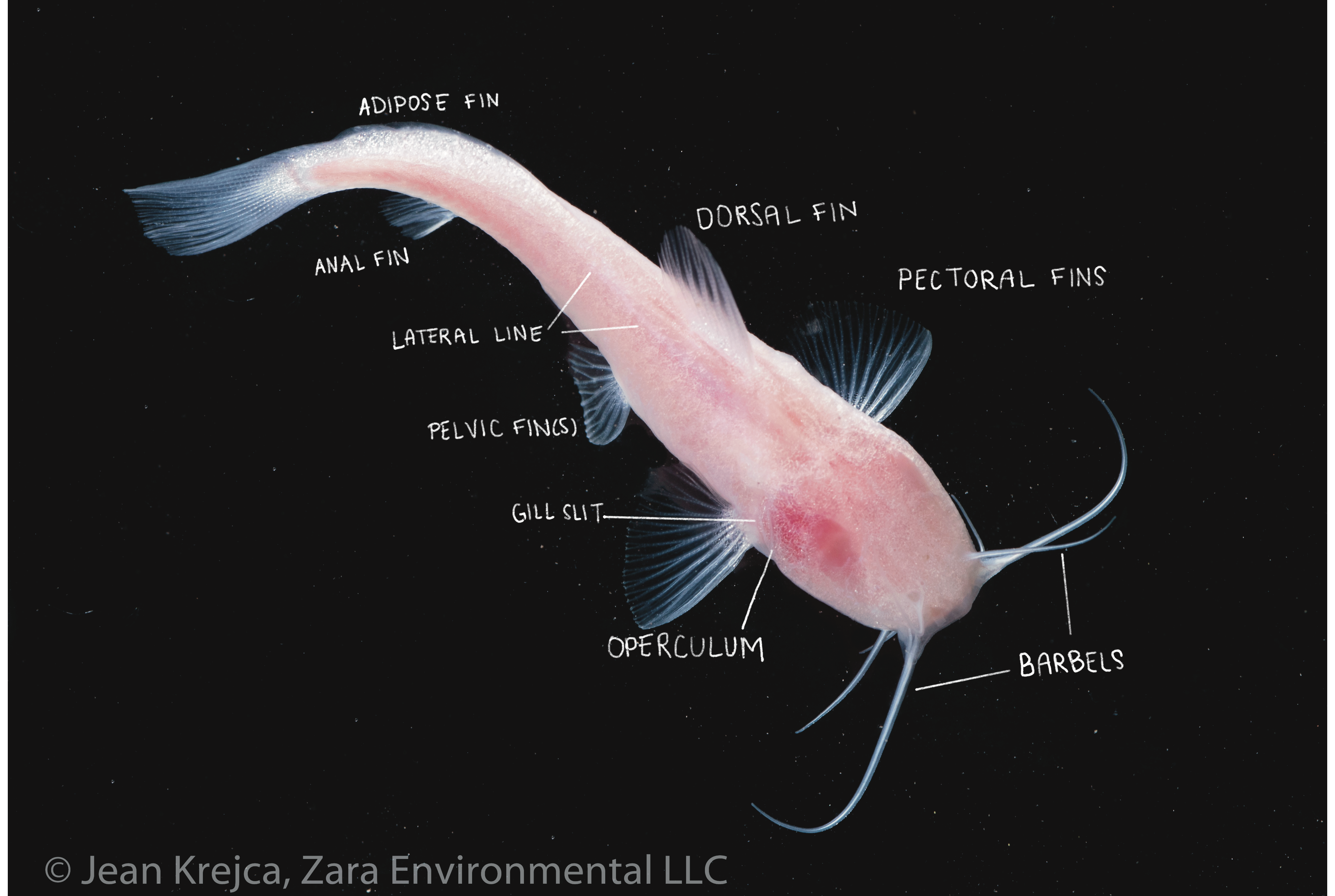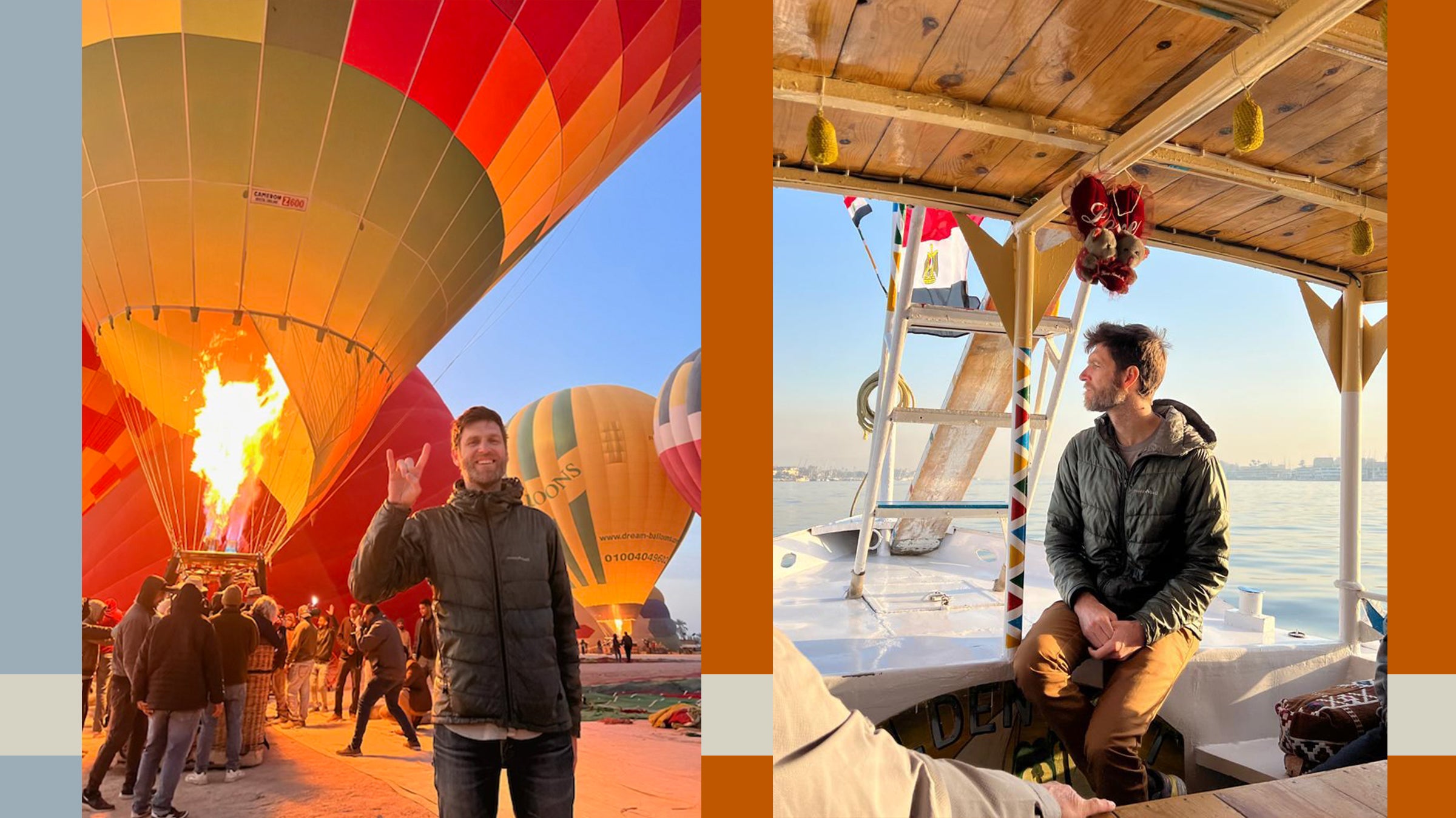BLINDCAT AND TADPOLE: A Creative Collaboration in Biodiversity

Left: book cover Right: (from left to right) Bianka Santillan, illustrator; Lisa Johansson, author; Dean Hendrickson, peer-reviewer; Andy Gluesenkamp, peer-reviewer. Standing in front of the headwaters of the San Felipe Creek, Del Rio, TX.
Lisa Johansson is a Texas-based author of children’s books. She recently collaborated with Dean Hendrickson, Curator in the Ichthyology Collection, to create the book Blindcat and Tadpole.
Blindcat and Tadpole is an illustrated children's book that was released in December 2024 by Texas A&M Press. Blindcat and Tadpole tells the story of a tadpole (named “Tadpole”) who gets swept away from his pond in a flash flood. Tadpole falls in a sinkhole and into a karst aquifer, an underground water resource created by the dissolution of water soluble rocks. In this aquifer, Tadpole meets a fish with no eyes, the endangered Mexican Blindcat (named “Blindcat.”) Blindcat agrees to guide Tadpole out of the caves and introduces him to his lightless ecosystem. Tadpole relies on his other senses to navigate through the underground cave. He learns this underground environment can be impacted from runoff water and dangers from above.
While the name “Mexican Blindcat” certainly may make the reader imagine quite a character, the species (Prietella phreatophila) is a real cave fish that lives in aquifers of Coahuila, Mexico, and Southern Texas in aquifers that connect beneath the international border.
In this interview, Lisa explains how her book came to be.
What inspired you to write this book?
My family lived in Del Rio for 5 1/2 years while my spouse served two tours at Laughlin Air Force Base. I fell in love with the people of Del Rio during our first tour, and on our second tour I fell in love with the land. At first Del Rio felt hot and inhospitable, but as I spent more time at the San Felipe Creek and Lake Amistad, I developed a deep respect for the environment.
My professional training is in meteorology, and I served as a Weather Officer in the U.S. Air Force for four years. While in Del Rio, I taught science at the local high school. My coworker was a retired Park Ranger from Lake Amistad, who was the first person to tell me about the Mexican Blindcat. I recently finished a lesson on the water cycle when I came up with the story. I literally jotted my idea down on a post-it note.
During this time, my family sailed on Lake Amistad and visited the San Felipe Creek often. I found myself wondering what caves were underneath me, what lived down there, and how I might get to explore a real cave.
After driving past the beautiful mural of the Mexican Blindcat downtown, I knew I had to create the story. I felt it was special and I wanted to share it with the community.

The Mexican Blindcat mural in Del Rio, Texas by Roger Peet for the Center for Biological Diversity's Endangered Species Mural Project, in collaboration with the Casa De La Cultura, Del Rio.
Tell us about your illustrator, artist Bianka Santillan?
Bianka is a well-known painter and muralist in Del Rio. I knew I wanted her to create illustrations to bring the story to life. Because she is a native from Del Rio, it makes the collaboration special. I reached out to her via email to ask if she would consider illustrating the story. She believed in the story and concept, and we established a relationship and formal contract to create hand-painted illustrations.
I applaud Bianka for doing an amazing job! We collaborated over a long period of time. Neither one of us had created a book before, so we learned along the way. I gave her a daunting task: paint animals you are not familiar with, make it vibrant, appealing to kids, and biologically accurate! She meticulously observed the species in person and online. She proceeded to create illustrations better than I could have imagined!
Anatomy diagram of a Mexican Blindcat. Photo by Jean Krejca, Zara Environmental LLC.
How did you work with Dean Hendrickson and the Ichthyology Collection?
I cold-emailed Peter Sprouse, expert caver whose company, Zara Environmental, LLC, had shared a lot of Mexican Blindcat Photos. I told him I was creating a children's book about the Mexican Blindcat. Peter was enthusiastic and introduced me to Dr. Andy Gluesenkamp from the Center for Conservation and Research at the San Antonio Zoo. Andy was enthusiastic and introduced me to Dean.
After meeting Dean, I wanted to visit him at the Ichthyology Collection because he is, in my mind, the world expert on Blindcats. I listened to his "Fish of the Week" podcast multiple times before arriving. Dean and Adam Cohen showed me all around, answered hundreds of questions and gave me a tour I'll never forget! I was in awe. Seeing so many species, some that may be extinct, highlights the fragility of our freshwater resources.
For example, I held a jar containing Satan Eurystomus, a fish that has not been seen at the surface in decades due to an increase in groundwater pumping. How cool is that? My visit to the Ichthyology Collection drove home the point that it was extremely important for me to produce and share my book.
Following the visit, Dean introduced me to Ms. Margie Crisp, a published author at TAMU Press, who introduced me to Dr. Andrew Sansom, who is known as the “Teddy Roosevelt of Texas” for his conservation efforts over decades of work. Dr. Sansom is founder of the Meadows Center for the Environment, who sponsored the production of the book.

Left: Limestone terrain surrounding Lake Amistad, Del Rio, TX. The Mexican Blindcat was found in a cave by Amistad Reservoir. Right: Lisa on a karst hike near Lake Amistad. Scientists, Park Rangers, and volunteers searched the area for new caves and potential habitats for Mexican Blindcats.
Tell us about your audience response?
So far, I am happy with responses from readers. Parents and teachers love the book as a story and science resource. The encouragement and support I have from my peer-reviewers, Hendrickson and Gluesenkamp, is the best compliment of all.
We are always looking for ways to expand our audience on these important topics of biodiversity and conservation. So I intend to produce a second book about more aquatic species in Texas. Stay tuned!
Where can readers either buy or check out your book?
Readers can purchase directly from TAMU Press or through Amazon. I kindly ask any and all readers to request for their local library to purchase the book! I want Blindcat and Tadpole in libraries and classrooms across all of Texas.
It sounds like this was a very transformative and positive experience, yes?
Absolutely! My takeaway is: when you find a topic of interest and engage with enthusiastic mentors, you can accomplish a lot. I want people to be aware of the amazing biodiversity all around us! Awareness causes us to care, and caring causes us to make better decisions and policies.




